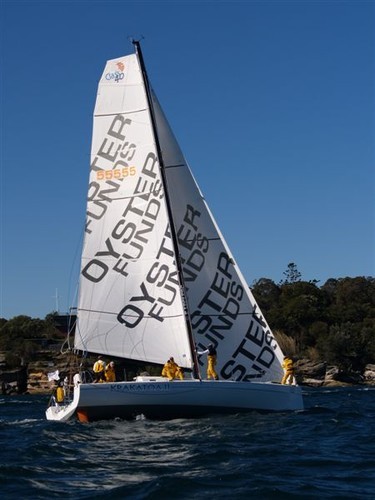European Class 40 to take on Rolex Sydney Hobart
by Jim Gale on 24 Dec 2007

Rod Skellet’s Krakatoa II, Photo: Ace Marine SW
Over the last couple of years, Europe’s offshore sailors have discovered a new, inexpensive route to thrilling, high speed sailing. They have discovered Class 40 racing.
In the last three years the class has taken off. This year more than 60 new Class 40 yachts have been sold in Europe.
The class comes from France. Class 40 yachts are designed to be sailed single handed, and with their wide beams, twin rudders and water ballast, they are intended as a stepping stone between Mini-Transats and Open 60’s.
But whereas these other classes have lots of carbon, canting masts and keels and every other hi-tech go-fast imaginable, and are expensive as a result, the Class 40 concept was built around the demands of sailors for an affordable fast, fun boat.
The only carbon is in the spars. The rest of the boat is solid fibreglass. The keel is fixed, the amount of water ballast limited. What is unlimited, though, is the downwind sail area. You can fly the biggest spinnaker you dare.
In the last three years the class has taken off. This year more than 60 new Class 40 yachts have been sold in Europe. Several big companies now produce production Class 40 boats, including the French giant Finot, which sells a cruising and a racing version, the Pogo 40.
It’s a Pogo 40, Krakatoa II, that Sydney yachty Rod Skellet will take to Hobart.
'She’s just the most enjoyable boat to sail,' Skellet says. 'In anything more than 45 degrees apparent wind (reaching) there is so much horsepower. She can sit on 12, 13 knots all day, no deceleration, and she has no bad habits. You can literally sail at 18 or 19 knots with one hand on the tiller and the other holding a coffee.'
Sounds great for the sort of thrills and spills racing a Frenchman might adore but a Rolex Sydney Hobart is a different beast altogether. Sure, everyone dreams of a 628 nautical mile downwind sleigh ride, but no-one holds their breath.
'In the right conditions we could get to Hobart in among the 47 footers in three days. I would be wrapped but realistically we have to expect at least some upwind work,' Skellet concedes.
This time of year those southerlies just roll through and woe betide anyone caught in the current off NSW or clawing their way across Bass Strait. Forget the glamour of La Rochelle and the Cote d’Azur, this is down and dirty Aussie sailing to test both boat and crew. It is, after all, what makes the Rolex Sydney Hobart one of the toughest ocean races in the world.
Skellet has beefed up the boat, made her stronger, and put four reef points in the mainsail so that he can get it down to the size of a storm sail.
'These boats are wickedly fast downwind but there is a lot to learn to get them fast upwind. Because of the water ballast and the twin rudders she should be nice to steer up-wind. We really only need three guys on deck to trim her. But we haven’t had those sort of conditions yet so we will have to see how it goes,' he says.
Class 40 boats simply do not rate under the IRC rule. 'There is nothing you can do to rate well,' Skellet says, so his race will be all about getting across the line faster than the bigger boats. 'In an 82 boat fleet a top 50 finish would be satisfactory, but we could finish as high as 30 if the gods smile on us.'
Presumably Rod Skellet is thankful he will be finding all this out in 2007. Last year the gods were in a decidedly unsmiley mood. The 2006 Rolex Sydney Hobart was a 628 nautical mile bash to windward for almost everyone. Spinnakers stayed bagged the whole way for all but the smallest in the fleet.
It was won by Love & War, a quintessentially 70’s IOR boat from an era when racing yachts, with their sculptured tumblehome and discreet transoms, were the exact opposite of the wedge shaped, utilitarian Class 40 philosophy. Beautiful to look at, great upwind, but cumbersome and slow downwind.
The modern IRC grand prix racer is a lot more fun, and a lot better behaved than its IOR forebears, and Krakatoa II is, after all, the first Class 40 yacht to reach Australia. Still, Rod Skellet is sure that in the future more Australian sailors will develop a European taste for exhilarating speed at a price they can afford.
If you want to link to this article then please use this URL: www.sail-world.com/40209